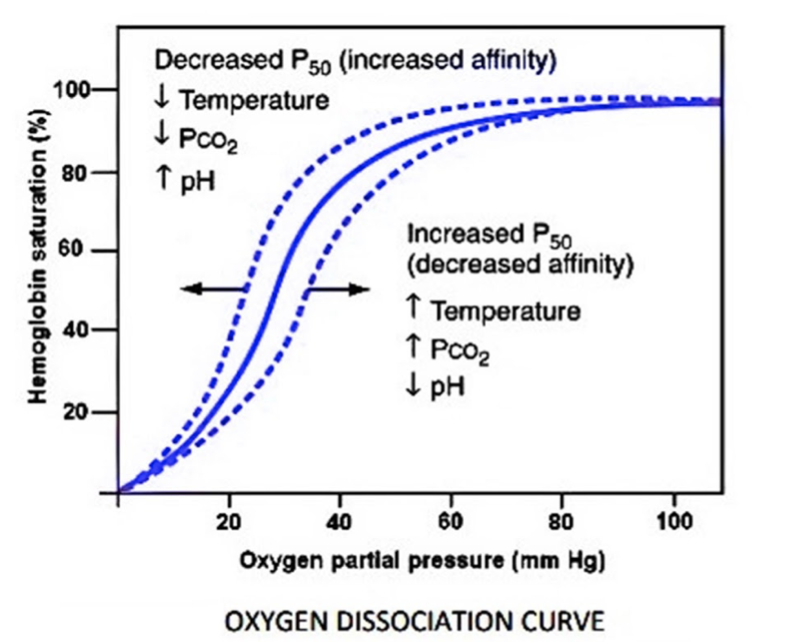
What is the effect of p${ CO }_{ 2 }$ on oxygen transport?
Answer
566.7k+ views
Hint: The partial pressure of ${ CO }_{ 2 }$ (p${ CO }_{ 2 }$) and the partial pressure of ${ O }_{ 2 }$ (p${ O }_{ 2 }$) and the relative difference between their values is what decides the rate and direction of diffusion at the different parts of our body.
Complete Step by Step Answer:
Oxygen is transported in the blood by hemoglobin which forms a complex known as oxyhemoglobin while doing so. The binding of oxygen to this hemoglobin depends on a number of factors such as p${ CO }_{ 2 }$, p${ O }_{ 2 }$, and $H^+$ concentration.
If p${ CO }_{ 2 }$ is high, ${ H }^{ + }$ concentration is high and p${ O }_{ 2 }$ is low along with high temperature, then in such conditions, the dissociation of oxyhemoglobin is favored. This means that oxygen will be used for cellular respiration instead of being transported.

If p${ CO }_{ 2 }$ is low, ${ H }^{ + }$ concentration is low and p${ O }_{ 2 }$ is high along with low temperature, such conditions favor the formation of oxyhemoglobin and thus oxygen is likely to be transported.
Additional information: Regulation of oxygen transport is also done via the neural system.
Respiratory rhythm center: This is a specialized region present in the medulla region of the brain which can detect ${ CO }_{ 2 }$ and ${ H }^{ + }$ concentration increase in the blood and thus make changes to reduce them.
Pneumotaxic center: Pneumotaxic region helps in the functioning of the respiratory rhythm organ by signaling it in the case of high ${ CO }_{ 2 }$ and ${ H }^{ + }$ concentration.
There are not many roles of the ${ O }_{ 2 }$ in the regulation of its transport.
Note:
- $97\%$ of oxygen is transported in the blood in the form of oxyhemoglobin. The other $3\%$ is transported as a dissolved gas in the plasma.
- $20\% - 25\%$ of ${ CO }_{ 2 }$ is transported by hemoglobin and $70\%$ of it is transported as bicarbonate ions. And the remaining $7\%$ is transported as a dissolved gas in the plasma.
- The formation of bicarbonate ions from ${ CO }_{ 2 }$ and ${ H }_{ 2 }{ O }$ is catalyzed by the enzyme carbonic anhydrase.
Complete Step by Step Answer:
Oxygen is transported in the blood by hemoglobin which forms a complex known as oxyhemoglobin while doing so. The binding of oxygen to this hemoglobin depends on a number of factors such as p${ CO }_{ 2 }$, p${ O }_{ 2 }$, and $H^+$ concentration.
If p${ CO }_{ 2 }$ is high, ${ H }^{ + }$ concentration is high and p${ O }_{ 2 }$ is low along with high temperature, then in such conditions, the dissociation of oxyhemoglobin is favored. This means that oxygen will be used for cellular respiration instead of being transported.

If p${ CO }_{ 2 }$ is low, ${ H }^{ + }$ concentration is low and p${ O }_{ 2 }$ is high along with low temperature, such conditions favor the formation of oxyhemoglobin and thus oxygen is likely to be transported.
Additional information: Regulation of oxygen transport is also done via the neural system.
Respiratory rhythm center: This is a specialized region present in the medulla region of the brain which can detect ${ CO }_{ 2 }$ and ${ H }^{ + }$ concentration increase in the blood and thus make changes to reduce them.
Pneumotaxic center: Pneumotaxic region helps in the functioning of the respiratory rhythm organ by signaling it in the case of high ${ CO }_{ 2 }$ and ${ H }^{ + }$ concentration.
There are not many roles of the ${ O }_{ 2 }$ in the regulation of its transport.
Note:
- $97\%$ of oxygen is transported in the blood in the form of oxyhemoglobin. The other $3\%$ is transported as a dissolved gas in the plasma.
- $20\% - 25\%$ of ${ CO }_{ 2 }$ is transported by hemoglobin and $70\%$ of it is transported as bicarbonate ions. And the remaining $7\%$ is transported as a dissolved gas in the plasma.
- The formation of bicarbonate ions from ${ CO }_{ 2 }$ and ${ H }_{ 2 }{ O }$ is catalyzed by the enzyme carbonic anhydrase.
Recently Updated Pages
Why are manures considered better than fertilizers class 11 biology CBSE

Find the coordinates of the midpoint of the line segment class 11 maths CBSE

Distinguish between static friction limiting friction class 11 physics CBSE

The Chairman of the constituent Assembly was A Jawaharlal class 11 social science CBSE

The first National Commission on Labour NCL submitted class 11 social science CBSE

Number of all subshell of n + l 7 is A 4 B 5 C 6 D class 11 chemistry CBSE

Trending doubts
10 examples of friction in our daily life

One Metric ton is equal to kg A 10000 B 1000 C 100 class 11 physics CBSE

Difference Between Prokaryotic Cells and Eukaryotic Cells

1 Quintal is equal to a 110 kg b 10 kg c 100kg d 1000 class 11 physics CBSE

State the laws of reflection of light

Explain zero factorial class 11 maths CBSE




